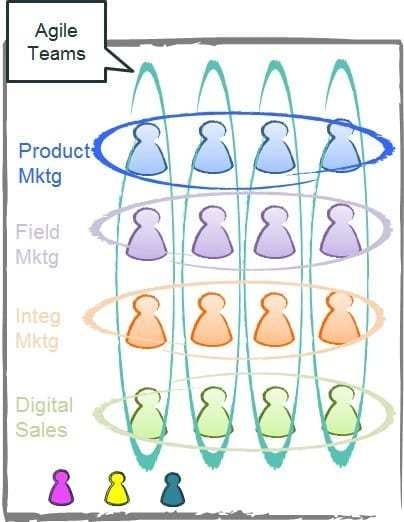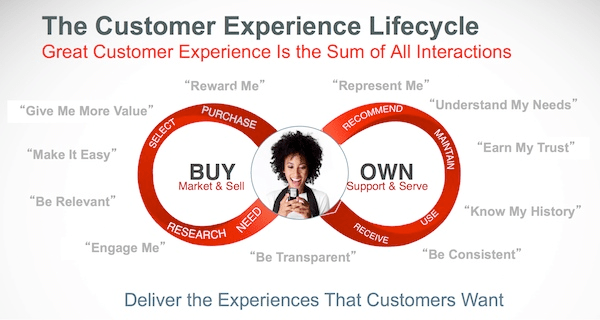In our first post in the series about Scaled Agile Marketing we looked at whether you even need Agile Marketing. In this post we talk about the typical triggers that cause marketing leaders to take a serious look at Agile Marketing.
Scaled Agile Marketing is typically needed as part of a real Agile Marketing transformation — an attempt to achieve a significant change in how marketing is operating. Agile Marketing at the team level is something that can happen bottoms up or in islands in the organization. The point where scaling is needed is typically when marketing leadership decided they need a serious transformation across the marketing organization or at least big swaths of it.
While most of the marketing organizations we see score pretty high on the “do you need Agile Marketing?” scale, Only a few of them then go and do something about it. While many of them agree with Agile Marketing at the concept level, They really need a strong trigger before they take action on it.
So let’s look at a couple of common triggers for a serious Agile Marketing transformation at scale.
New Marketing Leadership
One very common trigger for any sort of change is when new leadership comes in and takes a fresh look at things. Agile Marketing might come about as a result of concerns about competency of the marketing organization or a desire to modernize how things are being done. Poor marketing campaigns results or dissatisfaction from business leaders is a common reason marketing leadership gets replaces in the first place. The new leader coming in hears things like “We don’t know what the marketing organization has been wasting its time on” or “They don’t speak our language, confuse us with their own metrics we don’t care about”.
Another situation is when a new marketing leader is brought in to help scale the marketing organization and realizes that the current structure/process is unscalable, bottlenecked, slow, and reliant on a few “heroes”.
Innovation / Customer Experience
As marketing leaders take on more and more responsibility for the whole customer experience and specifically the whole digital experience, they realize their current slow/siloed approaches are unfit for the pace of innovation and learning needed to “nail” the right customer experience. Being able to close a fast learning loop and run mini “innovation labs” as part of more and more of the marketing organization not just the “cool kids” in the corporate innovation lab is a typical requirement we hear about.
We Tried Agile and Failed
Many people try Agile Marketing in the small by mapping directly from the Agile Development. They send a few people to classic agile training (e.g. a Scrum Master class) or ask some coaches from the development side to help them out. Then a few weeks/months later they’re so confused and struggling that they either throw it away (Which is a shame but isn’t a trigger for a real agile transformation…) or they realize they need to look the things in a deeper more holistic and pragmatic manner.
Need to Scale Agile beyond a few small experiments
Similar to trying and failing, but these organizations tried some small agile experiments and understand they need to look at it differently now that they want to scale it further.
Drowning in work
This is especially popular with middle managers that are trying to make ends meet with more and more workload and the same (or in some cases even fewer) people.
Alignment with the Development/IT/Technology side of the house
As Dev/IT/Technology organizations move to Agile/DevOps approaches, Many marketing leaders feel the need to align their language, process, cadence with the way their peers are working and talking.
Revamping the Marketing Technology Stack
As marketing organizations try to build a modernized marketing technology stack many of them are realizing that they need an effective adaptive process to help deal with these complex projects. Since much of a marketing technology stack improvement project includes technology/development work it makes sense to everyone to use an agile approach for it. This then cuts across to some of the marketing-style work that is associated with the new technology stack, which in many cases brings about a wider discussion about an agile operating system for marketing.
Implementing a new marketing approach — e.g. Social Selling, Content Marketing, Account Based Everything
Trying a new approach to marketing involves a lot of uncertainty and complexity and collaboration across silos. Smart marketing leaders connect the dots and realize Agile Marketing is the right approach for figuring out how to effectively do Content Marketing, Social Selling, Account Based Everything, or whatever new thing you’re trying.
Now that we understand the benefits of Agile Marketing as well as the typical timing marketing leaders look at this, we’re ready for the next post where we will talk about whether you actually need to scale when you move towards Agile Marketing.
Page 2
In earlier posts in our Scaled Agile Marketing we looked at whether you even need Agile Marketing and then what typically triggers a serious discussion about Agile Marketing. In this post we move to the next step — figuring out if you need Scaled Agile Marketing.
So — Do you need Scaled Agile Marketing?
Scaling isn’t just a function of the number of people in the marketing organization. It’s more a function of how many marketers need to work together as part of one customer journey/experience.
Let’s look at an example. In the diagram below you can see a typical marketing organization that would possibly have a need for some scaling approach. They have agile teams that cross-cut the different marketing functions — focusing on delivering marketing value/impact for a specific product/customer journey rather than focusing on a specific marketing function/task.

Map it to your organization. If your teams are truly autonomous and work on separate backlogs and activities with minimal dependency then you might not need a full-fledged scaling approach.
If on the other hand they ARE working on one bigger customer journey, have some dependencies across teams and some floating specialists that need to be involved in multiple teams or are considering synergies and adjacency campaigns (e.g. If you’re using an agile ALM tool you can probably benefit from our Continuous Integration or Portfolio-level tools), a scaling approach would benefit you.
In this context SAFe’s Agile Marketing Train (A name coined in the field for the Agile Release Train in the context of Marketing) with its Program Increment Planning, Single Program Backlog, System Demos provide useful guidance.
Working with Agencies
In many cases marketing organizations work with external marketing/advertising agencies to deliver some of their campaigns or some of the materials for their campaigns. In most cases the way these relationships work don’t map well to “everybody working on one agile team” and some sort of scaling solution is required.
A rising trend is the “Internal Agency” model (see https://hbr.org/2015/07/6-reasons-marketing-is-moving-in-house) in which an internal agency is created as a shared service that supports the various lines of business in the organization. While getting rid of the dependency on an external vendor, this “shared service” presents its own scaling challenges.
SAFe provides a couple of options for how to deal with internal/external “suppliers” — for example they can become separate “supplier” Agile Marketing Train on a bigger Solution Train or a “supplier” team that is a “component”/”specialized” team inside an Agile Marketing Train. In any case SAFe provides guidance for how to involve them in a planning and execution cadence and how to create realistic plans considering their capabilities and availability without forcing them to be members of agile teams (although that is certainly an option and will be recommended in some cases).
Longer-term activities such as events, strategic campaigns
Most agile marketing organizations run a mix of high-tempo testing that is a great fit for agile iterations/flow with frequent planning but also some longer-horizon activities such as conferences, webinars, big product launches, that require more predictability and visibility beyond the “next 2 weeks” that classic team-level agile provides.
SAFe’s combination of high-tempo team-level agility with the Program level with it’s Program Increment Planning, Roadmap, visibility to Features helps deal with this mix of demands from the marketing organization.
There’s a preference for SAFe in the enterprise
In many organizations Marketing is following the product development/management organization into Agile. If product development/management organization chose SAFe as their agile approach, you will benefit from using it as your approach as well.
Same framework means using the same language. Even after adjusting SAFe to a marketing vernacular, it is still SAFe and marketers will be able to understand developers and vice versa.
Same framework means ability to share expertise, knowledge, training. While Agile Marketing isn’t exactly Agile Development a good agile coach or SAFe Program Consultant (SPC) can learn the marketing nuances over time.
Using the same framework means you’re better prepared for the day you will actually bring product development and marketing into the same customer experience value stream. While the typical starting point is for marketing to create “Agile Marketing Trains” focused on the marketing/customer journey value stream, many organizations are executing a “Digital Transformation” which means emphasis on the digital experience that combines both marketing/sales and usage touchpoints. (See Oracle’s Customer Experience Lifecycle for an example)

With this one bigger customer life-cycle in mind, more and more organizations have a vision of creating “Agile Customer Experience (CX) Trains” combining development, marketing, sales and others. These trains are needed in order to iterate and learn at the speed needed to compete in the digital age. Starting from the same or similar framework will ease the transition to these sort of trains — reducing the babel tower effect that might happen otherwise.
If you see a need for agile marketing AND your context fits at least some of these descriptions/environments, you probably need some scaled agile marketing patterns, which will be the topic of our next blog in the series.
Originally published at yuvalyeret.com on July 11, 2017.
